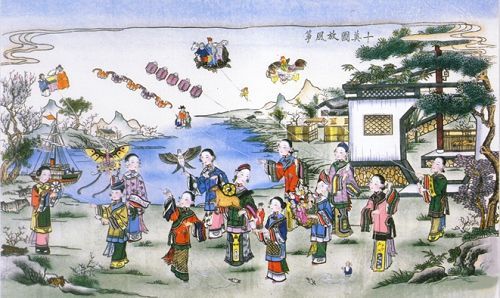| Home > China Feature |
Kate Flying

Kite flying is a traditional sports game widely popular among the Chinese people. The kite, dubbed the earliest flying object of man kind, originated from China over 2,000 years ago. Legend has it that in the Spring and Autumn Period, Lu Ban, the great building master, made a bird-shaped wooden kite that could fly in the air. After that, paper was used to make kites, which were therefore called “paper kites”. Starting from the Han Dynasty, kites were used for measurement and sending messages. In the Tang Dynasty, the kite was introduced to neighboring countries like Korea and Japan. In the Five Dynasties, a bamboo whistle was tied to a paper kite, giving out a sound like the zheng (stringed plucked instrument in some ways similar to the zither) under the force of wind. That’s why the kite is called “fengzheng” (meaning “zheng in the wind”) in Chinese. In the Song Dynasty, kite flying gradually became an entertainment among the people, and in the Yuan Dynasty, it was introduced to various countries in Europe.
To make a kite, you need to make the frames first with thin bamboo strips, then paste paper or silk to the frames, and finally tie a long thread. Thus a kite is born. It flies into the sky under wind force. There are two major types of kites - “hard-winged” and “soft-winged”. The former can stand greater wind pressure than the latter and therefore fly higher. But “soft-winged kites” fly further than their “hard-winged” counterparts. The shapes of kites include traditional birds, beasts, worms and fishes. In addition, some new shapes like human figures have been developed in recent years.
Kite flying as a sport has a long history in China. Beijing is one of the best-known hot spots for kite flying. Many remote areas have also joined in the fun recently. In 1989, the International Kite Federation was officially established, with the headquarters in Weifang of Shandong Province.
Art
 more
moreChina Beijing International Diet ...
Recently, The hit CCTV documentary, A Bite of China, shown at 10:40 ...

Exhibition of Ancient Chinese Jad...
At least 8,000 years ago, Chinese ancestors discovered a beautiful...

Longmen Grottoes
The Longmen Grottoes, located near Luoyang, Henan Province, are a tr...

Custom
 more
moreWeb Dictionary
Martial Arts
Tai Chi Master Class Held in Moscow
MOSCOW, June 15, 2016 (Xinhua) -- Students learn from Shaolin ...
Celebriting 70 years' efforts in restoring Mogao...
Work is being carried out at the restoration site of cave No 98 a...
Hong Kong Children's Symphony performs in Seattle
Under the theme of Tribute to the Golden Age, a concert featuring a ...





 print
print  email
email  Favorite
Favorite  Transtlate
Transtlate 








